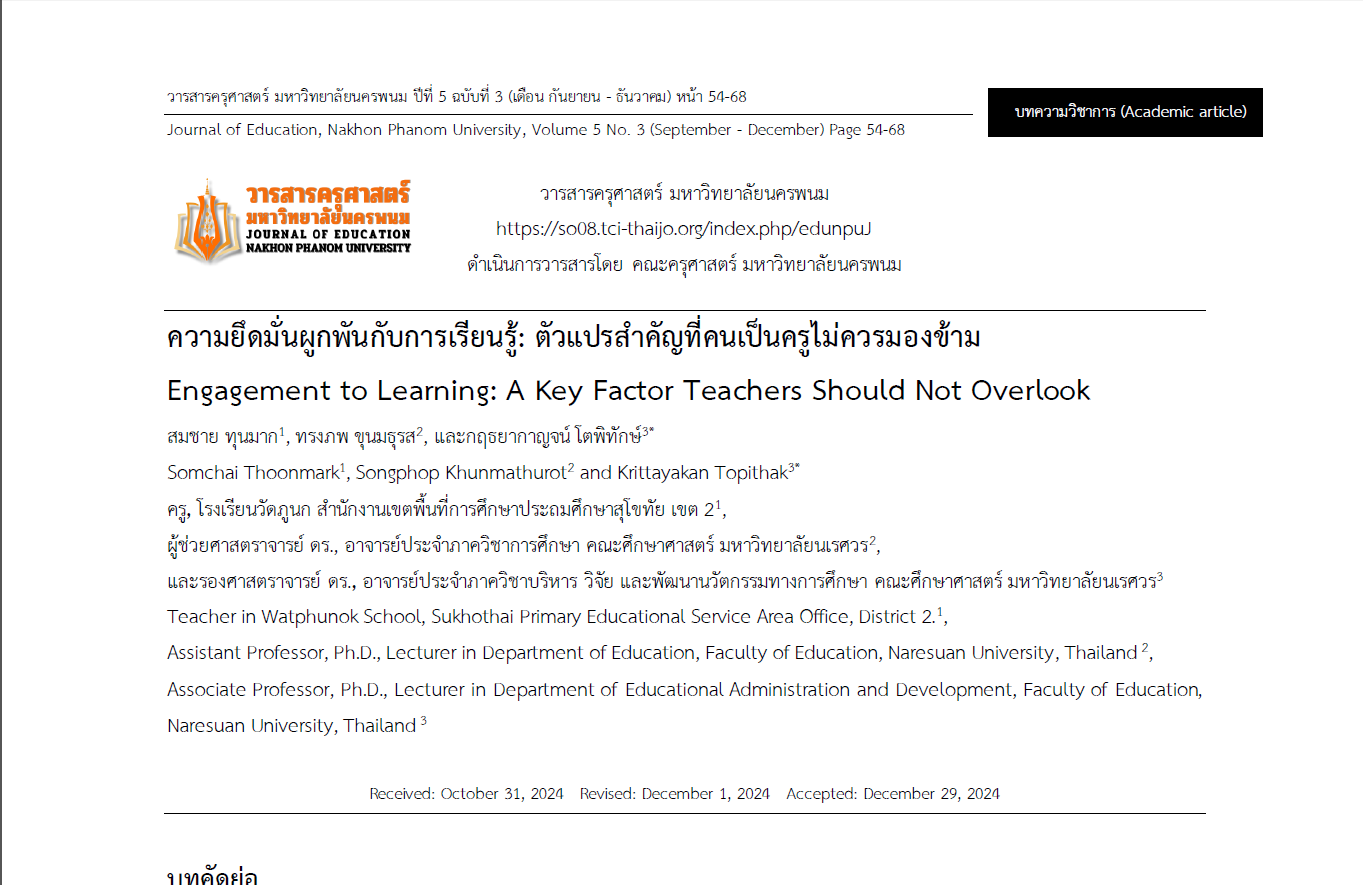Engagement to Learning: A Key Factor Teachers Should Not Overlook
Main Article Content
Abstract
The purpose of this article was to present the content and significance of student engagement with teachers, providing the concept and the role of teachers in managing a classroom where student engagement differs. Additionally, the article explored current trends in educational research related to commitment to learning, offering suggestions for future studies. It emphasizes the examination of this variable as more than just a confounding factor by integrating it as an independent variable of interest. This approach provided insights into effective methods for controlling and studying the variable. The findings revealed benefit the application of instructional strategies that fostered student development in knowledge, skills, and positive attitudes toward learning. Finally, this contributed to shaping students into lifelong learners equipped for the challenges of the 21st century.
Article Details

This work is licensed under a Creative Commons Attribution-NonCommercial-NoDerivatives 4.0 International License.
บทความที่ได้รับการตีพิมพ์เป็นลิขสิทธิ์ของวารสารครุศาสตร์ คณะครุศาสตร์ มหาวิทยาลัยนครพนม ข้อความที่ปรากฏในบทความแต่ละเรื่องในวารสารครุศาสตร์เล่มนี้เป็นความคิดเห็นส่วนตัวของผู้เขียนแต่ละท่านไม่เกี่ยวข้องกับมหาวิทยาลัยนครพนม และคณาจารย์ท่านอื่น ๆ ในมหาวิทยาลัยฯ แต่อย่างใด ความรับผิดชอบองค์ประกอบทั้งหมดของบทความแต่ละเรื่องเป็นของผู้เขียนแต่ละท่าน หากมีความผิดพลาดใด ๆ ผู้เขียนแต่ละท่านจะรับผิดชอบบทความของตนเองแต่ผู้เดียว
References
ชนัญชิดา ทุมมานนท์, ปิยวรรณ วิเศษสุวรรณภูมิ, ชุติมา สุรเศรษฐ, จรินทร วินทะไชย์, ชนิศา ตันติเฉลิม, และดุสิดา
ทินมาลา. (2564). ผลของการจัดการเรียนการสอนด้วยวิธีการเรียนรู้แบบผสมผสานที่มีต่อระดับการยึดมั่นผูกพัน
ในการเรียนของนิสิตระดับปริญญาตรี. วารสารศึกษาศาสตร์ มหาวิทยาลัยนเรศวร, 23(2), 140-151.
https://so06.tcithaijo.org/index.php/edujournal_nu/article/view/244878/168006
ทิพอาภา กลิ่นคำหอม. (2556). โมเดลเชิงสาเหตุของความยึดมั่นผูกพันของนักเรียนและผลสัมฤทธิ์ทางการเรียน
ที่เกิดจากอิทธิพลของครู [วิทยานิพนธ์ปริญญามหาบัณฑิต]. Chulalongkorn University Intellectual
Repository (CUIR). http://cuir.car.chula.ac.th/handle/123456789/43173
นพมาศ ว่องวิทยสกุล. (2557). การพัฒนาโปรแกรมเพื่อส่งเสริมความยึดมั่นผูกพันกับการเรียนและผลสัมฤทธิ์ทางการเรียน
วิชาภาษาไทยของนักเรียนชั้นประถมศึกษา: การทดลองแบบอนุกรมเวลา [วิทยานิพนธ์ปริญญามหาบัณฑิต].
Chulalongkorn University Intellectual Repository (CUIR).
http://cuir.car.chula.ac.th/handle/123456789/45811
ยุวดี พันธ์สุจริต. (2554). การวิเคราะห์โมเดลทางเลือกของความยึดมั่นผูกพันกับโรงเรียนที่มีต่อผลสัมฤทธิ์ทางการเรียน
ผ่านการเรียนรู้แบบลุ่มลึก [วิทยานิพนธ์ปริญญามหาบัณฑิต]. Chulalongkorn University Intellectual
Repository (CUIR). http://cuir.car.chula.ac.th/handle/123456789/26808
ลลนา เลิศจิระวงศ์. (2563). การพัฒนาความยึดมั่นผูกพันของผู้เรียนและความสามารถในการเรียนรู้คำศัพท์ภาษาจีนของ
นักเรียนชั้นมัธยมศึกษาปีที่ 4 ผ่านกิจกรรมสร้างสรรค์ [วิทยานิพนธ์ปริญญามหาบัณฑิต]. มหาวิทยาลัยธุรกิจ
บัณฑิตย์. https://libdoc.dpu.ac.th/thesis/Lalana.Ler.pdf
วิจารณ์ พานิช. (2556). สนุกกับการเรียนในศตวรรษที่ 21. กรุงเทพฯ: มูลนิธิสดศรี-สฤษดิ์วงศ์.
วิชัย วงศ์ใหญ่, และมารุต พัฒผล. (2562). การโค้ชเพื่อการพัฒนาศักยภาพผู้เรียน. กรุงเทพฯ: จรัญสนิทวงศ์การพิมพ์.
วิมลพันธ์ ทรายทอง. (2561). การศึกษาความสามารถในการแก้ปัญหาทางคณิตศาสตร์และความยึดมั่นผูกพันในการเรียนของ
นักเรียนชั้นมัธยมศึกษาปีที่ 5 ที่ได้รับการจัดการเรียนรู้โดยการสอนแนะให้รู้คิดร่วมกับการให้ข้อมูลย้อนกลับเพื่อ
ส่งเสริมการเรียนรู้ [วิทยานิพนธ์ปริญญามหาบัณฑิต]. มหาวิทยาลัยศรีนครินทรวิโรฒ. http://ir-ithesis.swu.
ac.th/dspace/handle/123456789/124
ศิริชัย กาญจนวาสี และชัยลิขิต สร้อยเพชรเกษม. (2557). ตัวแปรสำหรับการวิจัย: ความหมาย ประเภท การคัดเลือก การวัด
และการควบคุม. วารสารศึกษาศาสตร์ มหาวิทยาลัยทักษิณ, 14(1), 9-37. https://so02.tci-thaijo.org/index.
php/eduthu/article/view/45315/37497
สมชาย ทุนมาก. (2567). การพัฒนาความสามารถการเขียนเรียงความของนักเรียนชั้นมัธยมศึกษาปีที่ 5 ที่มีความยึดมั่นผูกพัน
กับการเรียนต่างกัน โดยใช้กระบวนการเรียนรู้เชิงรุกแบบรวมพลัง 5 ขั้นตอน (CO – 5 STEPs) ร่วมกับแบบฝึก ทักษะที่บูรณาการภูมิปัญญาท้องถิ่นจังหวัด
สุโขทัย [วิทยานิพนธ์ปริญญามหาบัณฑิต]. มหาวิทยาลัยนเรศวร. http://nuir.lib.nu.ac.th/dspace/handle/123456789/6294
อุทุมพร ภักดีวงศ์. (2562). การพัฒนารูปแบบการเรียนการสอนภาษาอังกฤษเพื่อส่งเสริมความผูกพันของผู้เรียนและ
ความสามารถทางการอ่านและการเขียนภาษาอังกฤษของนักศึกษาระดับปริญญาตรี [วิทยานิพนธ์ปริญญาดุษฎี
บัณฑิต]. มหาวิทยาลัยธุรกิจบัณฑิตย์. https://dric.nrct.go.th/Search/SearchDetail/308567
Hart, S. R., Stewart, K. & Jimerson, S. R., (2011). The Student Engagement in Schools Questionnaire (SESQ)
and the Teacher Engagement Report Form-New (TERF-N): Examining the Preliminary Evidence.
Contemporary School Psychology, 15(67-79). https://www.casponline.org/pdfs/pdfs/2011_
journal_all_001-144-b.pdf
Li, J. & Xue, E. (2023). Dynamic Interaction between Student Learning Behaviour and Learning
Environment: Meta-Analysis of Student Engagement and Its Influencing Factors. Behavioral
Sciences, 13(1), 59-74. https://doi.org/10.3390/bs13010059
Skinner, E.A., & Belmont, M.J. (1993). Motivation in the classroom: Reciprocal effects of teacher behavior
and student engagement across the school year. Journal of Educational Psychology, 85(4), 571-

